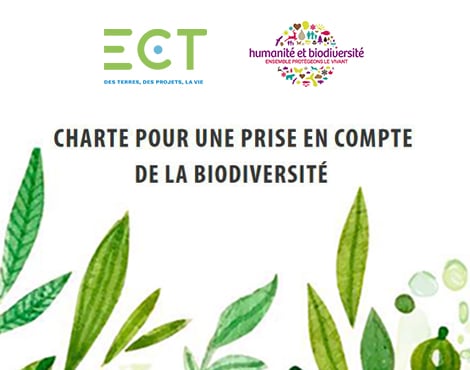ECT adds an operational methodology to its commitment to biodiversity
In 2019, ECT and the Humanité & Biodiversité association signed a charter for commitment to biodiversity. 2020 marks a new stage in this partnership; the charter contains methodological guidance with very practical applications for the design and development of ECT sites.
Methodological guidance for operational implementation
Working with Humanité & Biodiversité, ECT defined its various commitments to biodiversity. The business then looked at the development of methodology to promote the practical implementation of these commitments in the design of its projects. The broad principles and ambitions for ECT’s land-use developments are defined in the search and development phases of the project, so it is essential that biodiversity considerations play a central role during these phases. The purpose of this guidance is to propose ways and means to deal with this.
The projects carried out by ECT must comply with the law in force, both in terms of the Code de l’Environnement and the town planning code, the Code de l’Urbanisme. The objective of these guidance sheets is to propose a proactive approach that makes it possible to go beyond the requirements of the regulations. Projects carried out by ECT are well suited to taking biodiversity into account and promoting it, because the goal of the projects is to transform industrial or degraded sites into multifunctional developments that favour societal and environmental well-being.
Biodiversity can thus be taken into account at each stage of the development of a project.
Prepared in a ‘guidance sheet’ format to form a guide for the use of ECT’s development departments, this methodology is intended to be applied in a practical way and to evolve to reflect user feedback.
A reminder of the 9 commitments in the charter co-signed by ECT and Humanité & Biodiversité:
FOCUS 1: Fully realise the potential of ECT sites for promoting biodiversity
E1 – Incorporate biodiversity issues into the strategy of the business, and take advantage of the development of ECT projects to achieve positive initiatives for biodiversity, from the search phase up to completion and subsequent follow-up.
E2 – Adopt a regional vision, and combat the fragmentation of landscapes, reduction in natural soil cover and loss of biodiversity. ECT’s sites are an opportunity to increase the area favourable to biodiversity and to work on reinforcing ecological continuity.
E3 – Develop a shared vision across the Group so as to incorporate all the environmental elements, and the interdependence between man and nature, into the design, execution and follow-up of projects.
FOCUS 2: Provide education concerning biodiversity issues, and make people aware of the possibilities that ECT sites offer for biodiversity
E4 – Inform, train and mobilise personnel (both administrative and operational) concerning biodiversity issues at every stage of land-use developments (invasive species, protected species, etc.) and make them aware of the potential and opportunities presented for biodiversity of ECT’s sites.
E5 – Work with the interested parties (local authorities, town halls, local bodies, residents, associations, etc) to incorporate biodiversity issues into the design of the projects. There may be room to create a charter with the various interested parties for a particular project.
E6 – Promote full consideration of biodiversity on all sites, and communicate as much as possible concerning the issues of biodiversity, in particular by highlighting and developing flagship initiatives, increasing awareness and informing other users of the sites about the importance of conserving biodiversity.
FOCUS 3: Participate in the development of knowledge about biodiversity
E7 – In the context of scientific research programmes relating to biodiversity, and to meet the needs of associations, ECT makes available those sites that the business believes are of interest for the development of knowledge relating to biodiversity issues.
E8 – With a view to increasing knowledge of biodiversity, ECT develops partnerships, to ensure follow-up so as to understand changes in biodiversity and to adapt initiatives for the conservation and protection of the living world.
E9 – So as to allow for the dissemination and organisation of scientific knowledge relating to biodiversity, ECT undertakes to collect data that is relevant to biodiversity, regional policies, the circular economy, regional development and the consolidation of resources. This data, acquired in the context of projects pursued by ECT, will be placed at the disposal of public research programmes working in the fields mentioned above.
About the Humanité & Biodiversité association
Humanité & Biodiversité is an association which has the primary purpose of reinforcing awareness and consideration of all the synergies and inevitable links between humanity and biodiversity. In particular, it works for the conservation of diversity of living things and to promote the incorporation of biodiversity into all fields of activity, taking economic and social issues into account.

